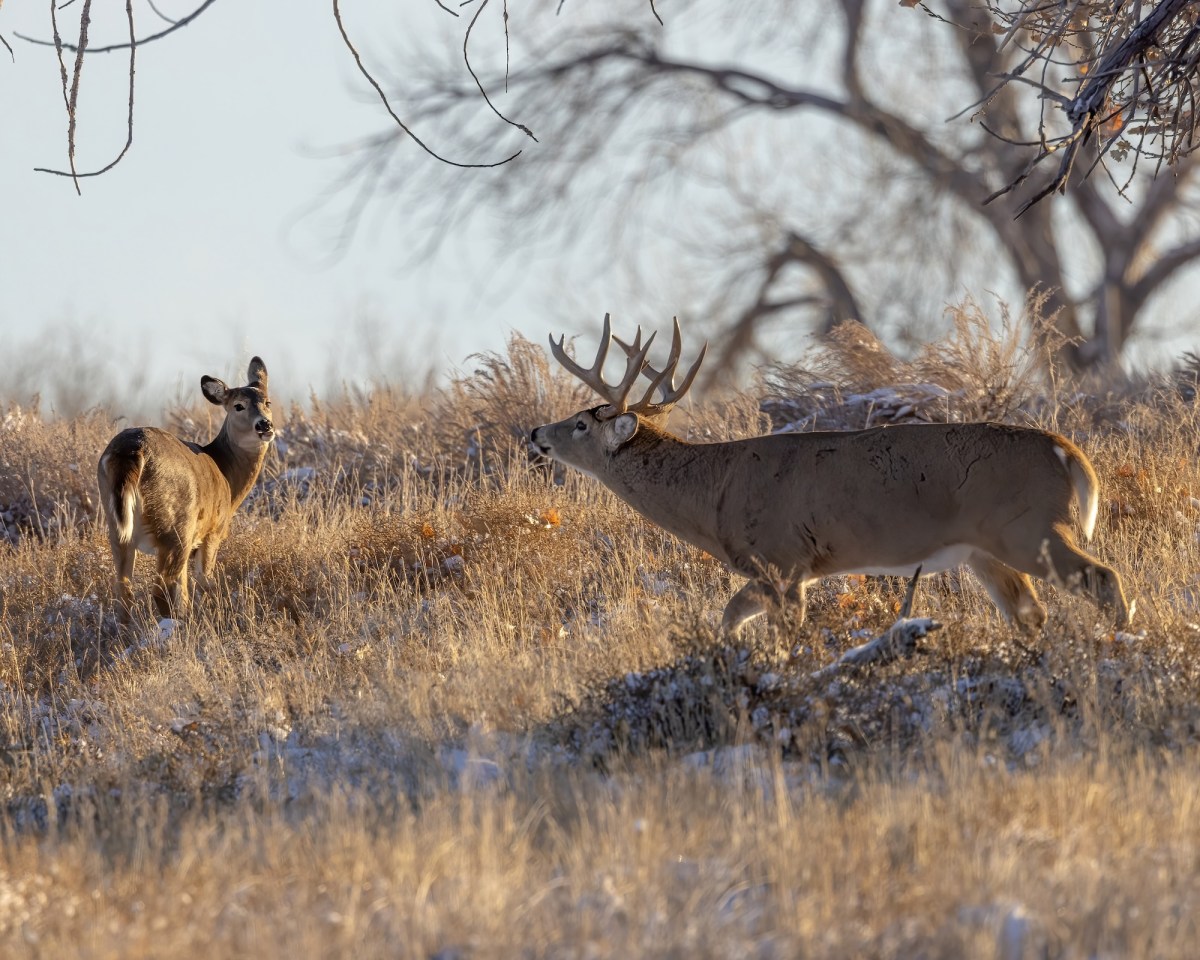This story was originally published in the November 2007 issue of Outdoor Life.
November is the time of year every deer hunter anxiously awaits. Throughout more than 90 percent of the whitetail deer’s range, bucks are going into rut.
Though you’re apt to see more deer on the move than at any other time of the year, it’s not enough simply to march into the woods and hang your stand on any old tree. First, you need a plan-a well-thought-out, takeeverything-into-consideration plan. Lucky for you, we’ve gone ahead and created a series of strategy maps to show you how to set up for the entire month of November.
Our hypothetical property is located in Booner County, USA. We’re above 35 degrees latitude, in a central state where whitetails go bonkers during the three phases of the November rut. Chances are, your spot is similar, with at least a few of the food sources, covers, woods, fields, ridges and funnels that you see on our place.
To get the most from this exercise, tweak our nine top stand locations to your land and the phases when you’ll do most of your hunting. You’ll see a bunch of deer, and with luck you’ll set your sights on a nice mature buck. The rest is up to you. Calm your nerves and shoot straight.
Stand 1: The Edge
Glassing in August and September and archery hunting in October, we saw more does in this field to the west than anywhere else. We hung a stand on the edge and let it sit untouched for weeks. Now we’ll slip in and hunt the stand hard. When one or two of those does pop into “first estrus,” bucks will smell them and come from all over. You might see a hot little doe trying to eat, with four or more rank boys nuzzling, charging, chasing and generally hassling the heck out of her.
Near or at dark, a thick-necked 8- or IO-pointer might charge out into the field, scatter the subdominant bucks like quail and try to corral the doe. With luck, he’ll roll out of the woods under your bow stand, or veer within 30 yards for a shot as he nudges the gal around. If you’re hunting with a muzzleloader, burn smoke and punch your tag early.
Quick Tips: Hang a stand in or near a thick field corner, where a big boy often pops out late. Be patient; little bucks will hassle does first, but a mature shooter will show up eventually — if not today, then maybe tomorrow evening.
Stand 2: The Pinch
This textbook “pinch” is a great spot to catch a big bruiser traveling from field to field and to each block of woods in search of one of the first hot does. Quiet, hidden, downwind access from the edge of the weed field makes the spot even better. This is a good ambush point in either the morning or the afternoon. You won’t see as many bucks here as you will in Stands 1 and 3, but it only takes one, right?
Quick Tips: A trolling buck will walk nose-down on a dry doe trail that curves around a deep pool of black water, hang a bow stand tight to a curve for a 20-yard shot.
Stand 3: The High Point
The closest hardwood ridge to a com crop is an obvious and awesome spot for a morning stand. The more smoking rubs and scrapes, the better. Don’t hunt on the
sign, per se, but on the muddiest doe trail you find that runs along or cuts across the ridge. Notice the good bedding cover close by and to the southeast. We’ll watch for a giant prowling there from the com or from the CRP to the north.
Quick Tips: The colder and frostier the morning, the more randy bucks you’ll see on a scrape-laced ridge; they’ll move until about 11 a.m. so sit tight.
Read Next: The Deer Hunting Gear We Trust
Peak Rut: November 11-21

Stand 4: The Weed Field
Many does sneak out into weed fields, ditches and other tight spots where bucks cannot chase them around. But they can’t dis the boys. A mature buck knows when a doe is on the verge of standing for him; he’ll pin her down in cover and stand guard for 36 hours, until he finally gets his way with her. With that in mind, we put this stand out in the CRP where we can look 300 yards in any direction for a buck tending a doe, or a loner prowling through the weeds still looking for one.
Quick Tips: Glass every nook and cranny of the overgrown field, then go back and glass it again; a buck bedded with a doe might stand up to stretch or run off another buck, and you’ll see him.
Stand 5: The Hillside
A hill that overlooks a cornfield is a good place for a morning rut stand, even if there’s not a lot of buck sign there. (Sometimes less sign is more; an old titan likes to get away from all the other wild, rutting bucks, so he carts his doe off to a secluded spot like this.) Plus, some deer will leave the crop field to the east and move up the ridge at first light. It’s a natural whitetail movement pattern that you might capitalize on here. The morning thermals will carry your scent up and away. This is the best setup on the map for solid scent control.
Quick Tips: A half- hour after sunup, ring the woods with some rattles and grunts. Dig a few mock scrapes near your stand and doctor them with strong tarsal scent; make a few fake rubs with a saw or rattling antler and spray them with buck scent too.
Stand 6: The Top Pick
If I had to pick only one stand for the 2007 rut, this would be it. Hang a tree stand or sit in a ground blind downwind of a spot where several finger ridges, draws and a creek bottom intersect. It’s a dumping ground for deer trolling or chasing through from any direction.
Pack a lunch, stay all day and you might spot an 8-pointer sprinting down a ridge, or a doe and a big IO-point climbing up out of a hollow, or yet another shooter standing in one of the ridge thickets, drooling over a doe that he’ll breed in a few hours. Keep an eye on that creek-deer will travel up and down and across it all day during the rut.
Quick Tips: Don’t blind rattle much, if at all, but If you see a buck pop out of a thicket or draw out of bow or gun range, stop him with a loud clash of antlers. Blow 10 to 12 deep, gurgling tending grunts every half-hour or so. Try some estrous doe bleats on a can-style call too.
Post Rut: November 22 to 30

Stand 7: The Return Trip
A University of Georgia study a few years ago found that around November 20, many bucks 2½ to 4½years old go back to checking and even reworking some old scrapes, hoping to hook up with the last estrous does. Okay, so we’ll go back and climb into Stand 3 on that ridge where we found a mother lode of scrapes and rubs three weeks ago. We won’t see as many bucks on the prowl as we did back then-some have been shot already and others have been spooked and gone nocturnal-but, hey, it only takes one shooter!
Quick Tips: Lay a doe-in-heat trail to your stand each morning; a buck might think he’s sniffing a last hottie as he marches toward your post.
Stand 8: The Pressure Player
Thanksgiving weekend (November 22-25) is the biggest gun-hunting holiday of the year. Play off the pressure. When hunters converge on a neighbor’s property to the southeast and start tromping around and shooting, some deer will run out of there and down the draw on our land. Set up a safe distance off the fence, 300 yards or more, and wear plenty of orange. Position your tree stand or blind on a sidehill or at the head of a hollow where you can see bucks crossing as they run from the pressure or chase a doe on natural movement. Watch the thickest pockets of cover. That’s where the old bucks will go. Get set up where you can make shots as they enter and exit these thickets.
Quick Tips: Sneak in early and hunt all day, because most of the guys across the fence will get cold and quit around 9 a.m. and then come back around 2 or 3 p.m. They’re apt to drive a deer to you anytime.
Stand 9: The Leftovers
From November 26 on, find some leftover feed and you’ll get your buck yet. Scout and glass all the crop fields in your area. Ninety-five percent of those fields will be picked clean and frozen. The other 5 percent, like the green-highlighted patch of soybeans in the field to the south, will hold a few last rows of feed, and that’s where you need to focus your efforts. A bruiser or two, along with some does, will hit that food until it’s gone, guaranteed, mostly in the evenings. But don’t count out morning visits. They’re liable to show up then as well.
Quick Tips: In the predawn or around 1 p.m., test the wind, sneak within 125 yards of the feed and set up in a blind, which is quieter than a tree stand and offers better cover now that all the leaves are down.
Read the full article here




